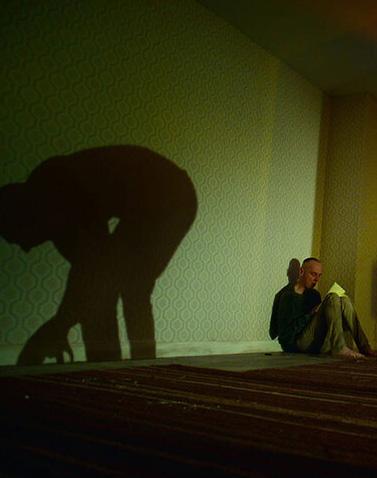
4 minute read
Psycho: Film as Conceptual Art Cian Donohoe
Psycho:
Film as Conceptual Art
Advertisement
Hitchcock is a lie. While many cinéastes swear that he is, unequivocally, the greatest director that has ever lived. Hitchcock - a man who is brand before he is a director - is nothing of this nature. Hitchcock is pulp more than prestige. Not in the realm of Bergman, or Fellini, or Welles - more De Palma and Verhoeven. Although it is undeniable that Hitchcock was some sort of master craftsman - akin to an Italian master of the High Renaissance, whose works were characterised by their experiments in symmetry and perspective; utterly ornamental, signifying nothing; nothing beyond prestige the work afforded to its commissioner. There is a precisiness, talent even, but ultimate plainness. It is, for a reason, an education in art history begins (and doesn’t end) with Da Vinci and not, say, Klimt or Egon Schiele. No, Hitchcock is rather entertainment for entertainment’s sake- a cultural barometer, rather than a prevailing wind; a prophet, rather than a God. This is not to diminish his achievements, of which there are many, but to dispel the ‘impregnability’ of Hitchcock’s oeuvre, to lay bare the nature of his work, and most cru cially advocate for Hitchcock’s liberation from this pretension which he, himself, might object to. Hitchcock is not the ‘final boss’ of cinema, but the opposite. He represents the convergence of two modes of the medium; he is where entertainment ends and cinema begins. An education in cinema should start with Hitchcock and end with Gaspar Noé. Verhoeven is the heir to Hitchcock, in that, while his films (shar
Psycho (Alfred Hitchcock, 1960) ing the same interest as Hitchcock in refracting sexuality, identity, etc.,) are masterfully crafted, they are nevertheless fiercely limited compared to their competitors in Europe (discounting Verhoeven’s latest release, Benedetta (Paul Verhoeven, 2021.) Nóe is a notable example, who transgresses formality, respectability and expectation with uncompromised artistic vision. Psycho (Alfred Hitchcock, 1960), for one, is highly entertaining - a masterwork of the horror genre, but still held to its limitations; it finds strength in its formula, and merely gestures to something beyond itself. The film, of course, centres on an encounter between Marion Crane (Janet Leigh) and a motel proprietor, Norman Bates (Anthony Perkins) in what develops into bloody murder, at the hands of Norman, motivated by his negative Oedipus complex. The film is a masterful filtering of sexual anxiety, corruptibility, identity through the medium, but stopping there - not transcendental, nor revelatory of something larger than itself, and makes no particular comment on either. At the risk of sounding like a contrarian, I found it nearly im possible to take most of Hitchcock’s films any more seriously than his direct progeny - the slasher. (Indeed, compare Fassbinder’s Martha (Rainer Werner Fassbiner, 1974) to Rear Window (Alfred Hitchock, 1954) and it is transparent who is the more painfully serious and completely uncompromising artist.) In Hitchcock, there is a particular pathos, eroticism, and excellence in reflecting horror, but a seeming lack of a sense of artistic vigour, hence his self-admitted boredom with directing. Although, there is no question that Hitchcock’s films indubitably provide something, and his countless imitators of various stripes prove this. In fact, like it or not, there is no denying that Psycho (1960) - a film that arguably represents the auteur at his most subversive, daring, and uncompromising - is simply one of the most influential films of all-time. Psycho has had an utterly unquantifiable influence on the art of cinema as a film that, aside from the obvious example of gialla and its American counterpart - the slasher 17


Psycho (Alfred Hitchcock, 1960)
film - has been paid tribute (and anti-tribute) to in superior films ranging from Fassbinder’s directorial debut Love Is Colder Than Death (Rainer Werner Fassbinder, 1969) to De Palma’s Dressed to Kill (Brian De Palma, 1980) or Ken Russell’s Crimes of Passion (Ken Russell, 1984.) André Bazin, is of a similar persuasion, understanding Hitchcock’s shortcomings, but appreciating mastery of the format and ability to entertain, stating that “a point of irony touching his entire oeuvre is the reminder of a certain between-thelines reading of the scenario by those who can see beyond the most obvious effects. Nonetheless, at times this marvellously oiled mechanism grates strangely on one’s ears. Through the rhetorical, conventional, and, in a word, reassuring sadism of American films, Hitchcock sometimes makes you hear, over the victim’s terrified screams, the true cry of joy that does not deceive you - his own.” It is true, also, that Hitchcock’s greatest films, chiefly Psycho and Vertigo, are only partly his, but also belong to those that interpret them. Hitchcock, much like, the Italian masters of the High Renaissance, has a remarkable ability to elevate his otherwise artistically timid films to something they are not - conceptual art. Cian Donohoe





